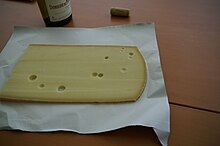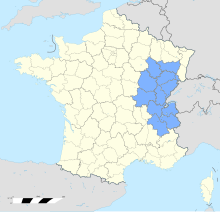Gruyère (cheese)
| Gruyère français | |
|---|---|
| country | |
| region | eastern France |
| Type of cheese | Raw milk cheese |
| Milk supplier | cow |
| description | |
| shape | wheel |
| size | ⌀ 53 - 63 cm and height 13 - 16 cm |
| Bleed | ivory to light yellow, pea to cherry-sized holes |
| bark | firm and grainy and from golden yellow to brown |
| Ripening time | min. 120 days |
| Nutritional information | |
| Fat content | 47 to 52% FiTr. |
| Dry matter | min. 62% |
| Salinity | 0.6 to 1.7% |
| Legal information | |
| protected term | IGP |
| Ordinance on protection | Official Journal of the European Union C 298/16 (PDF) of November 4, 2010 |
| Geographical area | |
The Gruyère français is a raw milk cheese , in the mountains of Savoie and Franche-Comté is made. In contrast to the Swiss Gruyere , the French has pea to cherry-sized holes.
Surname
The name “Gruyère” is derived from the Officiers gruyers , high forest officials who levied taxes in this region in the 17th century. Since it could be confused with the Swiss “Le Gruyère”, the EU Commission introduced the simultaneous naming of the country name in 2013 .
Manufacturing
The production area of the cheese with a protected geographical indication is limited to the departments of Ain , Côte-d'Or , Doubs , Isere , Jura , Haute-Marne , Haute-Saone , Saone-et-Loire , Savoie , Haute-Savoie , Vosges and Territoire de Belfort . The area borders directly on the Swiss region where Gruyere is made.
Only milk from local cattle breeds ( Abondance , Tarentaise , Montbéliarde , Vosgienne and Simmental française) may be used. These must be on the pasture for at least 150 days, genetically modified or silage feed is not allowed. The transport to the cheese dairy must not exceed six hours. Large copper kettles are used to process the milk, from which up to 14 loaves can be formed. The first grease is then applied.
The typical aroma arises from the production- related propionic acid fermentation . The cheese is first stored in warm ripening cellars, where the typical holes form, and only later brought to cooler cellars.
The 60 cm large and 15 cm high “cheese wheels” are put on sale at the earliest after 120 days of ripening.
Individual evidence
- ↑ a b Publication of an application for registration . In: Official Journal of the European Union . C, No. 298, November 4, 2010, pp. 14-19.
- ↑ Implementing Regulation (EU) No. 110/2013 of the Commission of 6 February 2013 for the entry of a name in the list of protected designations of origin and protected geographical indications (Gruyère (PGI)) . In: Official Journal of the European Union. L, No. 36, February 7, 2013, pp. 1-2.

